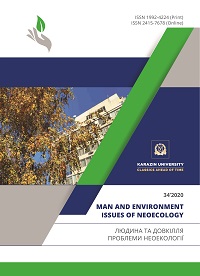The Study of Condition of the South Bug River Basin with Using Geoecological Methods
Abstract
Based on the analysis of the data set of the main hydrochemical indicators of the surface water quality and the analysis of the soil, it was found at some experimental points that the MPC of content of the studied indicators was exceeded. The content is exceeded at all sampling points, due to the high content of complexes with humic acid salts, secondary waterlogging of reclaimed lands. The main reason for the intake of nitrates into the water is the washout of fertilizers from fields and vegetable gardens. All surface water bodies have increased water hardness, its acidity is within normal limits.
Excess concentrations of alkaline hydrolyzed nitrogen, as well as phosphorus and potassium compounds at the sampling points indicate a high level of intensity of the farming system, in which the use of agrochemicals is given priority. However, long-term ingress of these compounds into the water body will accelerate the process of eutrophication in the near future. The loss of humus in the soils of agricultural lands adjacent to the rivers Sob, Dokhna, Ustya was revealed. In general, the geosystem of the Southern Bug River suffers from a complex anthropogenic impact, the main source of which is agricultural production.
Downloads
Published
Issue
Section
License
Copyright (c) 2020 Залізняк Я. І.

This work is licensed under a Creative Commons Attribution 4.0 International License.
Автори, які публікуються у цьому журналі, погоджуються з наступними умовами:- Автори залишають за собою право на авторство своєї роботи та передають журналу право першої публікації цієї роботи на умовах ліцензії Creative Commons Attribution License, котра дозволяє іншим особам вільно розповсюджувати опубліковану роботу з обов'язковим посиланням на авторів оригінальної роботи та першу публікацію роботи у цьому журналі.
- Автори мають право укладати самостійні додаткові угоди щодо неексклюзивного розповсюдження роботи у тому вигляді, в якому вона була опублікована цим журналом (наприклад, розміщувати роботу в електронному сховищі установи або публікувати у складі монографії), за умови збереження посилання на першу публікацію роботи у цьому журналі.
- Політика журналу дозволяє і заохочує розміщення авторами в мережі Інтернет (наприклад, у сховищах установ або на особистих веб-сайтах) рукопису роботи, як до подання цього рукопису до редакції, так і під час його редакційного опрацювання, оскільки це сприяє виникненню продуктивної наукової дискусії та позитивно позначається на оперативності та динаміці цитування опублікованої роботи (див. The Effect of Open Access).

